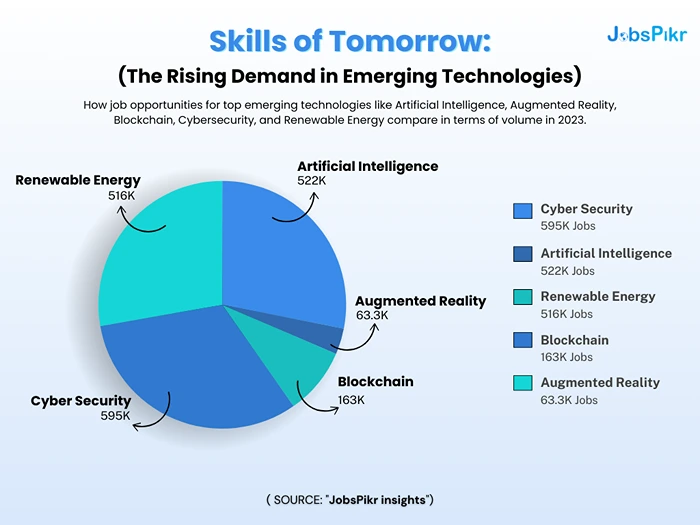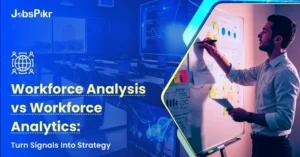- Why Hiring Feels Different in 2025
- What Workforce Insights Are and Why They Matter in 2025
- The Hiring Trends HR Teams Need to Watch in 2025
- How to Turn Workforce Insights Into a Hiring Strategy That Works
- How JobsPikr Turns Workforce Data Into Real Hiring Advantage
- Building a Workforce Strategy That’s Ready for What’s Next
- Smarter Hiring Begins with the Right Insights
Why Hiring Feels Different in 2025
Hiring has always been hard. In 2025, it’s harder, but for different reasons.
The roles companies need to fill are changing fast. So are the skills, expectations, and even the places people want to work. Flexible hours and remote options aren’t perks anymore, they’re the norm. And AI isn’t on the horizon; it’s here, shaping everything from job descriptions to candidate screening.
For HR and people analytics teams, this pace makes old-school planning risky. Annual headcount plans and static market reports don’t hold up when the workforce shifts every quarter. You need insight that’s live, specific, and practical enough to act on.

Image Source: DDI development
That’s where workforce insights come in—not vague summaries, but actual data on what’s happening across industries, roles, and regions in real time. JobsPikr helps uncover that. We scan job postings across markets so you can spot trends early, understand what competitors are doing, and make better decisions without waiting for someone else to catch up.
This isn’t about having more data. It’s about seeing clearly enough to act before the window closes.
What Workforce Insights Are and Why They Matter in 2025
“Workforce insights” sounds like something you hear in a vendor pitch and immediately forget. But when you strip away the jargon, the idea is simple: it’s real information about what’s going on in the labor market right now, what companies are hiring for, what skills are in demand, where jobs are opening up or drying up.
And in 2025, this isn’t a nice-to-have. It’s a must.
Here’s why: the pace of change in hiring has never been faster. New tech rolls out, roles shift, priorities change. You’re not just trying to fill open roles, you’re trying to predict what roles you’ll need next quarter, and whether you’ll even be able to fill them.
Workforce insights give you the information to make those calls. The key word, though, is “actionable.” Because there’s a difference between a static PDF report from six months ago and real-time, filtered data that tells you, for example, that demand for prompt engineers is suddenly spiking in mid-sized fintechs in Atlanta. The first sits in your inbox. The second shapes your next hiring sprint.
It also cuts through the noise. Not every job trend on LinkedIn is worth chasing. With the right insight, you can tell what’s actually shifting in the market, not just what people are talking about.
This kind of visibility helps HR teams do their jobs better:
- Plan instead of scrambling.
- Focus where it matters.
- Justify hiring decisions with real data.
It doesn’t solve every problem, but it puts you in control of what used to feel like guesswork.
The Hiring Trends HR Teams Need to Watch in 2025
You don’t need another blog post telling you “AI is the future” or “remote work is here to stay.” You already know that.
What you actually need is clarity. What’s shifting right now, what’s driving it, and how does it affect hiring, practically?

Image Source: AIHR
Here are five real trends shaping hiring in 2025, based on patterns we’re seeing in live job market data:
1. Remote Work Isn’t Novel—It’s Just Normal
Companies that still treat remote roles as experimental are behind. Flexibility has moved from a perk to a baseline expectation, especially for knowledge work. According to LinkedIn’s Future of Work Report (2024), remote job postings stabilized at around 14% of all listings in late 2024, but they attract over 50% of applications.
That demand isn’t going away. The signal is clear: if you don’t offer location flexibility, you’re cutting your talent pool in half.
2. AI Skills Are Moving Out of the Tech Bubble
AI roles are no longer just in tech companies. They’re showing up everywhere—finance, healthcare, logistics. JobsPikr’s job posting data shows consistent growth in demand for skills like prompt engineering, natural language processing, and model fine-tuning across sectors.
These aren’t fringe roles anymore. HR teams need to know how fast AI job demand is growing in their own industries, not just what’s happening in Silicon Valley.
3. Contract Work Is Eating into Full-Time Hiring
The gig economy isn’t just Uber drivers and freelancers anymore. More companies are using contract workers to fill highly skilled roles developers, UX researchers, and even data analysts.
This isn’t just about cost-cutting. It’s about speed and flexibility. Contract roles go live faster and fill faster. For some teams, they’re the only realistic way to get talent in fast-moving areas like AI or cybersecurity.
4. Companies Are Hiring Based on Talent Availability, Not Headquarters
You don’t need to build a satellite office to hire in a new region anymore. With remote hiring, teams are targeting cities where the skills are, regardless of where the HQ sits.
JobsPikr data shows more roles tagged to locations like Bengaluru, Warsaw, and Austin, not just New York or London. It’s smart hiring: go where the talent is, not where your org chart says it should be.
5. People Are Jumping Industries More Than Ever
The old logic—hire someone with ten years of experience in the same industry—is breaking down. People are moving between sectors all the time. A product manager leaves a SaaS company for a healthcare startup. A cybersecurity analyst moves from a bank to a government contractor.
It’s happening because many roles are now defined more by skills than by domain. And companies that hire for skills, not industry familiarity, are winning.
How to Turn Workforce Insights Into a Hiring Strategy That Works
Insight doesn’t matter unless it leads to action.
You can have dashboards, heatmaps, and a hundred pages of labor market data—but if you’re not using it to make decisions, it’s just noise. The goal is to translate real-time workforce trends into something useful: a hiring strategy that works in the real world, not just on paper.
Here’s how HR and people analytics teams are actually doing that.
1. Use Demand Data to Plan, Not Panic
Too many companies still hire reactively. A team loses someone, suddenly there’s a rush to fill the gap. Meanwhile, the talent pool for that role might have shifted months ago, and you’re now competing too late.
Good workforce insights give you lead time. If you’re seeing a steady rise in demand for AI specialists or compliance analysts, that’s your cue to start sourcing before the market gets saturated. Don’t wait for the hiring manager to raise the flag.
2. Rethink Location, Go Where the Talent Is
Let’s say you need to hire 30 cloud engineers this year. Your HQ is in Boston, but talent is expensive and hard to find there. Data from platforms like JobsPikr can show where the same talent is more available, maybe it’s in Raleigh, maybe it’s in Pune, maybe it’s remote altogether.
Instead of competing in the most crowded markets, shift your focus. Geo-targeted recruiting isn’t just cost-effective —it’s smarter.
3. Build Upskilling Programs Based on What the Market Actually Needs
Internal training is great—but only if it’s aligned with reality.
For example, if your training budget is going toward basic data literacy, but the market shows rising demand for data privacy or AI ethics, that’s a missed opportunity. Use workforce insights to guide what skills are worth developing in-house.
JobsPikr’s skill trend data can help show what’s climbing and what’s fading. That’s gold when you’re deciding how to invest in people.
4. Benchmark Your Hiring Against the Market (Not Just Last Year)
It’s not enough to say “we hired 10 engineers last quarter.” You need to ask: how does that stack up against your competitors? Are they hiring twice as fast? Offering better packages? Pulling from better locations?
Real-time job posting data helps you spot these shifts early. If you’re losing out on talent, it’s usually not a mystery. You just need better visibility into what others are doing.
How JobsPikr Turns Workforce Data Into Real Hiring Advantage
You don’t need more spreadsheets. You need signals—live, usable, and clear.
That’s what JobsPikr delivers. It’s not a reporting tool you check once a quarter. It’s a live feed of job market data that shows you what’s really happening across industries, skills, and regions, every single day.
Here’s how it works in practice:
Job Postings at Scale
JobsPikr tracks millions of job listings across markets. But it doesn’t just dump that data, it structures it. You can filter by skill, location, job title, company, or industry. You can see how demand is trending for a particular role in a specific city over the last 30 days. That’s real insight.
Skill Trends That Really Matter

Forget guessing which skills to build training around. JobsPikr’s trend data shows you what’s rising in demand, and where. For example, if you’re in the healthcare industry and you’re seeing a spike in listings mentioning AI-powered diagnostics tools, that’s a signal to rethink both your hiring and development strategy.
Hiring Activity Monitoring (Yes, Including Competitors)
Want to know what your competitors are hiring for? JobsPikr lets you track that too. If a rival suddenly ramps up hiring for a role you also need, it might be time to adjust your strategy or move faster.
It’s not about copying, it’s about not getting blindsided.
A Real-World Example
Let’s say you’re on the people analytics team at a mid-sized financial services firm. You notice applications for your data science roles have dropped sharply. You check JobsPikr and see that fintech startups in your region are aggressively hiring for the same roles, offering hybrid work and 20% higher salaries.
That’s not just interesting data. That’s a wake-up call.
You now have a reason to talk to comp & benefits, revisit your job descriptions, and maybe adjust where and how you’re sourcing candidates. Without that insight, you’d be stuck guessing.
Automated, Always-On
The real advantage: it’s continuous. JobsPikr isn’t a quarterly labor report. It updates constantly, so your team doesn’t have to chase stale data. That means you can check on hiring trends the same way you check your inbox—quickly, often, and with a clear sense of what’s changing.
Building a Workforce Strategy That’s Ready for What’s Next
Hiring isn’t just about filling roles. It’s about making sure your organization has the skills, structure, and flexibility to meet what’s coming, even when what’s coming is unclear.
That’s why a future-ready workforce strategy starts with workforce insights. Not once a year. Continuously. And not just by HR, this has to be a cross-functional effort, with input from talent acquisition, people analytics, business unit leads, and learning & development.
Here’s what that looks like in real terms:
Start With the Right Questions
Data is only useful if you know what you’re trying to solve. Ask better questions:
- What roles are becoming harder to fill—and why?
- Are we hiring too much from one geography or background?
- What skills are growing in demand that we’re not developing internally?
These questions help shape a workforce plan that isn’t just reactive.
Build a Real-Time Planning Cycle
Most workforce plans are still built annually. That’s too slow. You need a process that allows for quarterly or even monthly adjustments based on what’s actually happening in the labor market.
Tools like JobsPikr help feed this cycle with up-to-date data. You can track demand trends, competitor activity, or talent movement across industries—and adjust your strategy accordingly.
Link Hiring and Upskilling
Some roles will be filled externally. Others are better grown from within. A solid workforce strategy uses insight from both hiring trends and internal skill audits to decide where to invest in training.
For example, if you know demand for AI ethics roles is climbing, but you don’t see much internal interest, that’s a flag. Maybe you need a targeted reskilling initiative, or a plan to start hiring for it now before the market tightens further.
Keep Everyone at the Table
HR and TA can’t do this alone. People analytics needs to surface the signals. Finance needs to tie it to the budget. L&D needs to plan programs that match market shifts. The business needs to tell you where it’s going next.
A future-ready workforce plan isn’t a static document. It’s a living framework that gets sharper the more people contribute to it, and the more insight you feed into it.
Smarter Hiring Begins with the Right Insights
Hiring in 2025 isn’t about keeping up but staying ahead. The companies that win are the ones that see the trends early, understand them clearly, and act on them before everyone else does.
That’s what actionable workforce insights make possible. Not vague forecasts. Not reports that gather dust. Real signals, pulled from real data, that help HR and people analytics teams make better decisions faster.
JobsPikr gives you that edge. It doesn’t replace your team’s judgment, it sharpens it. You get a clearer picture of what’s happening in your talent market, so you can plan smarter, hire smarter, and stay ready for whatever’s next.
If you want to see how it works, take a look at what JobsPikr can do.




